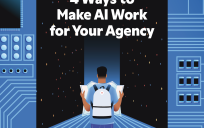 The role of a data analyst is evolving in the era of emerging artificial intelligence (AI). So much so, we might need to relabel this role as Analyst 2.0. Here’s a look at what Analyst 2.0 means for the next-gen data guru helping organizations use data for better decision-making.
The role of a data analyst is evolving in the era of emerging artificial intelligence (AI). So much so, we might need to relabel this role as Analyst 2.0. Here’s a look at what Analyst 2.0 means for the next-gen data guru helping organizations use data for better decision-making.
We are all swamped with data. Analysts have a hard time keeping pace with demands for intel that can only be gleaned through analytics. AI seems like the perfect answer—automating routine analysis and freeing up time for humans to focus on critical thinking. As the technology changes, so too does the job. The role of a data analyst, version 2.0 if you will, requires new thinking and brings a brand-new set of challenges.
The industry has questions about a future that dovetails with AI: How can we be sure that outputs from a computer are both accurate and relevant? How can we be confident that analytic tools are really working? What if the computer doesn’t have things quite right and faulty outputs are used for significant decisions?
And perhaps most significantly: Will AI eliminate the need for analysts?
Unfortunately, the current approaches to AI don’t resolve these questions—in fact, they only make them worse. All the hype around AI tends to focus on what the technology may be able to do rather than how it can be a practical tool that meets organizational objectives. Context is missing. AI outputs are complex. A data scientist—not an analyst—is needed to make sense of analytic results. All of which gives analysts the impression that AI will put them out of a job rather than freeing them up to do one.
The solution is not to leave the analysts out, but instead to make them central to every aspect of developing and deploying AI. When analysts play a key role, the analytic outputs are much more likely to be accurate and contextualized to the objective; the tools are more likely to be transparent, accessible, and trusted; and analysts are truly free to do the higher-level work that they are trained to do (and gifted at doing). In short, the key to harnessing the best of AI lies in the hands of analysts.
An AI can apply previous patterns, rules, and training sets to perform a triage on the flood of incoming data that analysts must access, explore, and interpret. The AI-enabled triage then can sort the important (for human eyes) data from the routine (typical, “look at later”) data, and an AI can even learn to apply relevant, contextual, and meaningful tags, annotations, and topical labels to the data that will allow easy search, discovery, and access by any analyst on the team at any time, not only by the one analyst who may have seen the data initially. AI has the power to deliver amplified, assisted, accelerated, and augmented intelligence to the human—that is real human-machine collaboration. That is AI-powered Analyst 2.0.
The “new” analyst
New technology naturally demands some new skills but the most important part of any analyst’s job remains the same: communication. Having a basic understanding of AI technologies and models will allow analysts to articulate their needs to others on their team, resulting in AI outputs that are useful, digestible, and actionable. In addition to these analyst-led teams, the role of Analyst 2.0 depends on:
- A close connection between analysts (who understand the project objectives) and the data scientists (who build the analytics);
- Technical teams, rather than siloed departments, to create and maintain algorithms by coordinating back office data processing and front office discovery;
- A sharing of knowledge and passing of the torch, from retiring baby boomers to digital natives. AI can be trained by today’s experienced analysts to “think like an analyst” when processing raw intelligence so that hard-earned analytic techniques are captured and disseminated for the benefit of incoming analysts;
- Development of a single AI interface that fuses multiple streams of raw intelligence into a curated (triaged and tagged), intermediate product that analysts can work from;
- Natural language processing that allows analysts to query the system with an easy-to-use interface;
- Open platforms and other architectures for ease in adding new data sources, data models, and software as they become available, regardless of source or vendor;
- Development of AI models on an iterative loop of agile development, with embedded feedback mechanisms so that analysts and their teams can adjust and fine-tune them; and
- Trust checks for analysts to adjust to and verify new workflows.
Who’s onboard?
The vision of Analyst 2.0 is not a ‘build it and they will come’ scenario. In fact, it constitutes a significant cultural shift, as we discussed in an earlier article about the importance of culture to AI adoption. Today’s analysts need time to transition to this new human-machine collaboration and to prove that AI is providing a positive and accurate way forward, or they will simply revert to the tools and workflows that they already know and use.
AI and other analytic approaches have the potential to fundamentally alter human work patterns, and analysts are justifiably wary of these changes. The reality is that no AI technology on the horizon can replace human judgment—and there has never been a greater need for the expertise, evaluation skills, and empathy of human analysts than today. AI and the evolved Analyst 2.0 role will allow this critical human resource to live up to its modern-day potential.
Want to read more about Analyst 2.0? Then read about the Emergence of AI Analysts or this thought piece: Redefining the Analysis Tradecraft.
Dr. Kirk Borne is a GovLoop Featured Contributor. He is the Principal Data Scientist and an Executive Advisor at management consulting firm Booz Allen Hamilton since 2015. In those roles, he focuses on applications of data science, data management, machine learning, and AI across a variety of disciplines. You can read his posts here.





Leave a Reply
You must be logged in to post a comment.